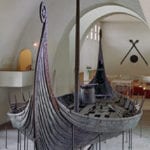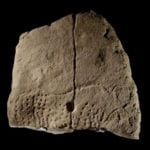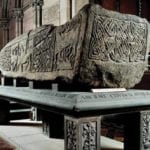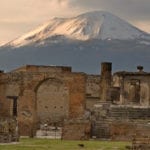 Animals
Animals  Animals
Animals  Gaming
Gaming 10 Game Characters Everyone Hated Playing
 Books
Books 10 Famous Writers Who Were Hypocritical
 Humans
Humans 10 of the World’s Toughest Puzzles Solved in Record Time
 Mysteries
Mysteries 10 Scientific Mysteries We Don’t Fully Understand
 Weird Stuff
Weird Stuff 10 Celebrities Who Have Admitted to Alien Encounters
 Our World
Our World 10 Surprising Secrets of Notre Dame Cathedral
 Miscellaneous
Miscellaneous 10 Intriguing Origins of Popular Carnival Rides
 Weird Stuff
Weird Stuff Ten Unexpected Discoveries Involving Vomit
 Movies and TV
Movies and TV 10 Actors Who Almost Didn’t Take Career-Defining Roles
 Animals
Animals 10 Amazing Animal Tales from the Ancient World
 Gaming
Gaming 10 Game Characters Everyone Hated Playing
 Books
Books 10 Famous Writers Who Were Hypocritical
Who's Behind Listverse?

Jamie Frater
Head Editor
Jamie founded Listverse due to an insatiable desire to share fascinating, obscure, and bizarre facts. He has been a guest speaker on numerous national radio and television stations and is a five time published author.
More About Us Humans
Humans 10 of the World’s Toughest Puzzles Solved in Record Time
 Mysteries
Mysteries 10 Scientific Mysteries We Don’t Fully Understand
 Weird Stuff
Weird Stuff 10 Celebrities Who Have Admitted to Alien Encounters
 Our World
Our World 10 Surprising Secrets of Notre Dame Cathedral
 Miscellaneous
Miscellaneous 10 Intriguing Origins of Popular Carnival Rides
 Weird Stuff
Weird Stuff Ten Unexpected Discoveries Involving Vomit
 Movies and TV
Movies and TV 10 Actors Who Almost Didn’t Take Career-Defining Roles
10 Archaeological Excavations Of The Germanic World
Since its inception as a science, archaeology has taught us a lot about ourselves, our ancestors, and what the world was like in the distant past. It offers us a glance into the histories of various cultures and delivers a narrative of their collective lives. The Germanic tribes were societies of ancient Europe, various peoples dating back to the Bronze Age who lived coinciding with the mighty ancient Rome.[1] Many European roots trace back to Germanic descent, and many of these forgotten peoples strongly influenced what would grow up to be the Western cultures of today, even if they and their contributions to our world were overshadowed by the awesome power of Rome.
The Romans and ancient Germans clashed lot, engaging in battles in and around the Rhine. Julius Caesar distinguished them from the Celts, another tribe with a presence in the area at the time. The Romans and ancient Germans traded goods when they weren’t conducting battle, and the two ended up often intermingling quite a bit. Finds in what used to be Germania have helped us see both the cultures of ancient Germania and ancient Rome more clearly. And many excavations have shed light on ancient battles, showing us exactly how people conducted the art of warfare. Here are ten Germanic excavations and their finds.
10 The Library Of Cologne
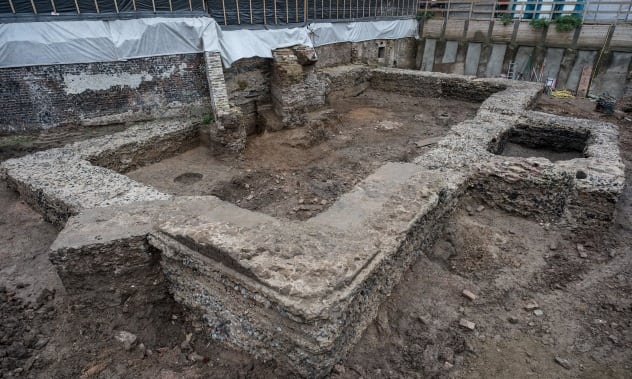
Recent archaeological digs have uncovered much that helps us peer into the world of ancient Germania. In 2017, four walls were unearthed during an excavation in Cologne. They are believed to date back to the second century AD, in a city which was originally Roman and called Colonia. As the walls were uncovered, a picture of an ancient building began to take shape.[2] Upon investigation, this building turned out to have been a library—and not just any library but an absolutely massive one for the time. It is believed to have housed up to 20,000 scrolls, which is a lot of reading material for the ancients . . . and this was a public library, belonging to an ancient Roman culture in a major trade and travel hub.
This shows us just how advanced the ancient Romans really were and how much they valued education, literacy, and knowledge. Perhaps access to education and literature is why Rome produced many of the greatest thinkers to ever live.
9 Kalkriese
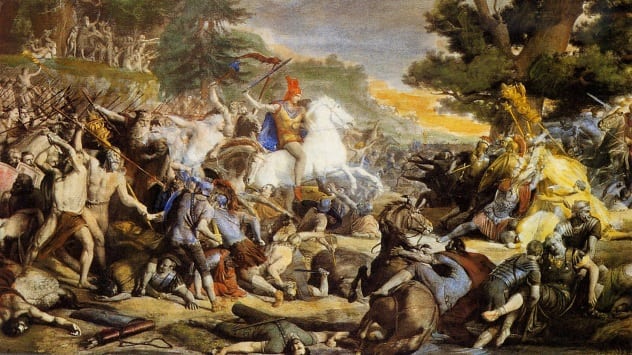
The Battle of Teutoburg Forest, one of the most decisive and foundational battles of Germany’s long history, took place in AD 9 against none other than their perpetual adversaries, ancient Rome. In this clash of two epic nations, the Germanic people defeated three Roman legions, quite a feat considering the awesome might of the ancient Roman army, in just three days. At Kalkriese hill, believed to be the site of the battle, they have found massive body pits, a Roman soldier’s face mask, and tons of other evidence of the major battle that is described in the literature.[3]
The body pits were actually likely pitfalls set up to entrap the Roman forces; the battle was highly strategic, and a Germanic chief named Arminius had been trained by Roman forces and knew exactly how to ambush them . . . and that’s exactly what he did. He united the Germanic forces, at that time various tribes, against the almighty power of Rome and came out victorious. This decisive battle is actually referred to as “the battle that stopped Rome,” in that it halted the unilateral Roman expansion further into Northern Europe, and, some 2,000 years later, the thousands of artifacts recovered at Kalkriese have helped piece together the story of what exactly happened back then.
8 Tollense Valley
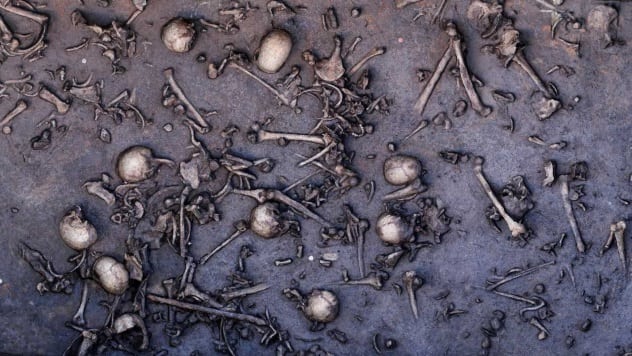
Another discovery of a much, much more ancient battle in Germania was made in the Tollense Valley in 1996, when an amateur archaeologist found an arm bone sticking out of a riverbank.[4] The Tollense Valley is about 120 kilometers (75 mi) north of Berlin, and a vicious battle took place here some 3,200 years ago between neighboring Germanic tribes. Spears, bows, arrows, horses, and, of course, bodies all clashed back then for whatever reason, and considering that it took place before writing had been invented by, or taught to, the Germanic tribes, we have no literary documentation to go on in trying to figure out what exactly happened in the Tollense Valley in 1250 BC, but we do know it was brutal.
Men were killed, slaughtered, and left to bob up and down in shallow ponds of water. This finding has shed a lot of light on the ancient people who lived—and died—here, often clutching merely wooden tools for a lack of much metal. It has taught us much about the landscape and trade routes used, and it’s likely there was a bridge here before it became the bloodbath that we know it as today.
7 Alken Enge
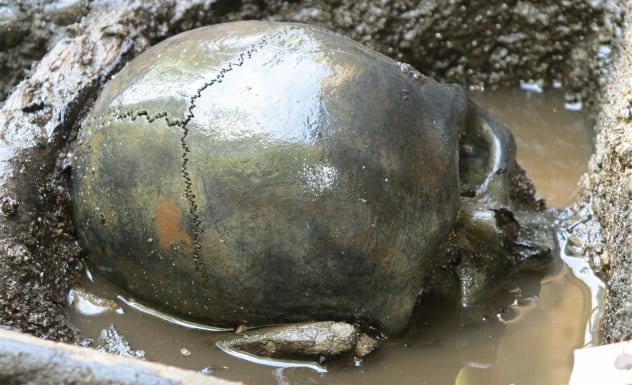
Another site which has taught us much about how these mysterious, ancient tribes did battle is the Alken Enge wetland in modern-day Denmark.[5] Alken Enge contains the corpses of at least 82 different people, maybe more, all who died in a single event from head traumas and other battle wounds. A battle definitely took place here, a brutal one, and many lives were taken. In total, 2,095 human bones or fragments were uncovered from the scene, along with Iron Age weaponry, and it is believed that the battle took place here sometime in the first century AD.
Probably the most interesting part of the find is that the bodies weren’t just strewn about like you’d expect for people who had died in battle; they were placed in decorative formations, laid out in specific manners with stones and other objects, and some of the bones had been tied to trees. Upon further inspection, it seems that Alken Enge may not have been the exact scene of the battle. Rather, the bog may have been used for the ritualistic burial of the Germanic soldiers who fought there. These bands of Germanic tribes held the bogs as a very sacred place and arranged the bodies of their dead ceremoniously to pay their respects.
The 185-acre scene is so massive that archaeologists and researchers believe they’ll never be able to unearth it all; they dig out small sections at a time. But what a rich glance into one of the most human moments, the burial of the dead, this site gives us as we look back on one of the most mysterious bands to live after the first century.
6 Osice
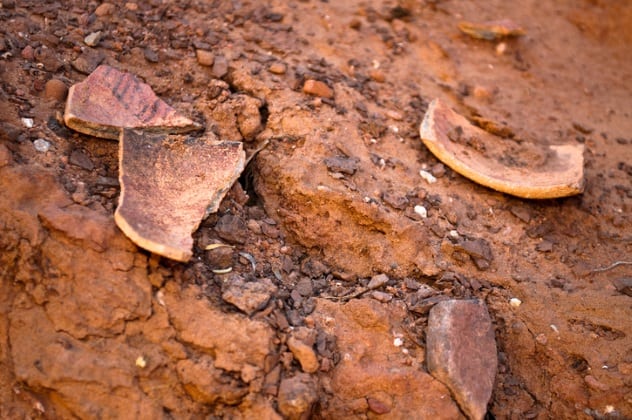
A less extreme find was discovered in the Osice region of Eastern Bosnia, excavated in 2005 and 2006. This gives us a glance into life in the region during the Roman era again, but far removed from bog bodies and ancient battles, this site revealed finds of a more everyday nature.[6]
Unearthing a sunken-in hut turned up pottery from the ancients, along with a wheel for making it. Tool handles were found for tens of various household tools, showing that the region housed a reasonably inventive people at the time, during the middle and late Roman periods. And unlike the crude barbarians often painted by Roman literature, here we find peoples who had cast bronze pottery and tools, as well as evidence to even suggest that they borrowed heavily from the ancient Roman method of creating things out of bronze, essentially recasting their day-to-day objects in the manner of the Romans.
The excavations also unearthed various burial methods of the ancient Germanic people, showing burial rituals when these tribes weren’t in battle, the burial of the common folk rather than the warrior. It seems that many of the intricate objects found were added to the graves of the people here to ceremonially pay respects to the dead.
5 Niederstotzingen
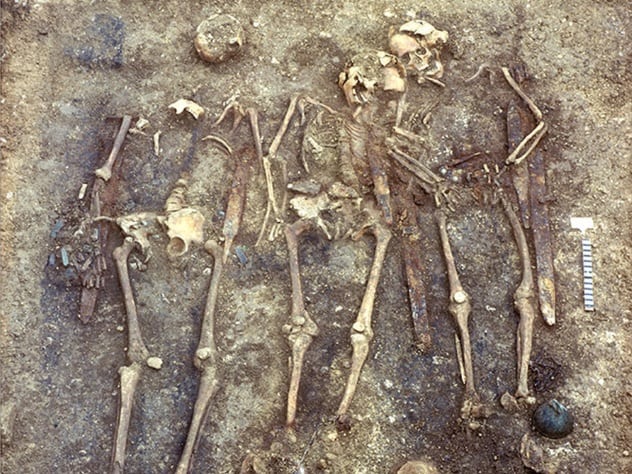
The Germanic tribes spawned from prehistory and lasted all the way through the Bronze and Iron Ages, through the Roman era, and through the Middle Ages, spawning the Anglo-Saxons and many of the other peoples of historical and modern Europe. The next site is a burial site in the south of Germany, a place called Niederstotzingen, and concerns the Germanic tribe who lived there during the sixth and seventh centuries. While little is known about the tribe, we know that they suffered a military loss to another Germanic tribe, the Franks, from whom they must have learned intricate and extravagant burial practices.
What’s more, the graves found at Niederstotzingen are of two genetically different groups of people who cohabitated. The two groups are divided into Niederstotzingen north and Niederstotzingen south, who DNA has revealed were not genetically similar. This shows two interesting things: that the tribes who lived there were culturally diverse and that they may even have practiced the adoption of children.[7] This turns the idea of medieval barbarians on its head and shows a society both adaptive and progressive for the day.
4 Gelduba
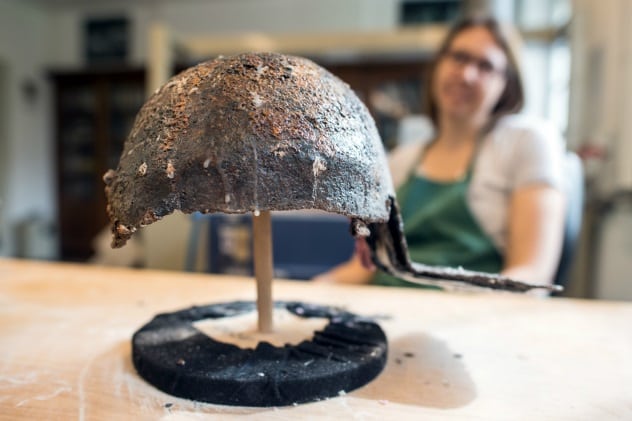
Another excavation comes from what was once the front lines of a battle. This one took place in an area known in ancient times as Gelduba and was yet another major battle between the Roman legions and Germanic tribes. How major was the battle? Some 20,000 of the fiercest warriors from the ancient world clashed here in what is modern-day Krefeld, Germany, a place to the northwest of Dusseldorf, located on the Rhine, which often served as a de facto barrier during their centuries-long strife.[8]
The battle took place in AD 69, and the area would trade hands and remain a long-standing Roman military outpost. Before the battle, Gelduba was an important Germanic city along trade routes and was home to a Germanic tribe called the Batavians, but it was seized by the Romans during the Batavian Revolt between 69 and 70 and remained under Roman occupation for a few hundred years. Roman helmets and coins were found dating from several centuries, as well as cemeteries and, yet again, lots and lots of bodies.
3 Rijnsburg
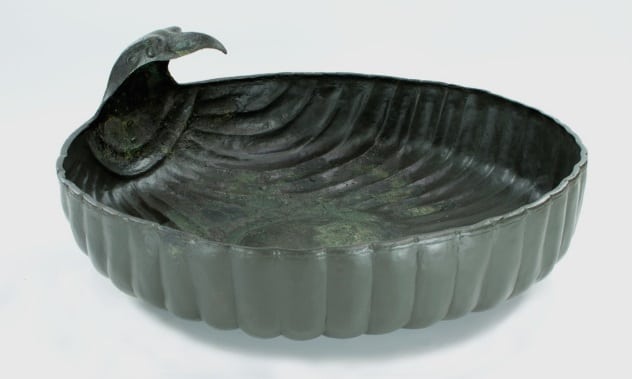
In a place in Western Netherlands called Rijnsburg, another excavation would turn up something rather astonishing that would further shed light on the ritualistic burial practices of the ancient Germanic people. Not only did they find ancient combs, which are thought to have been brought there by trade from what is today Northern Germany, and a bronze-cast Roman washbasin suggestive of trade with Roman military forces, but they found the cremated remains of three individuals.[9]
The site is dated to the fourth century AD, which means that this particular Germanic tribe cremated their dead by that time. It seems the basin was from a high-ranking Roman military general, who is believed to have traded it for favors from the tribes that lived there at the time. This also showed that the Romans had a presence in Netherlands significantly later than was previously believed.
2 Mainz
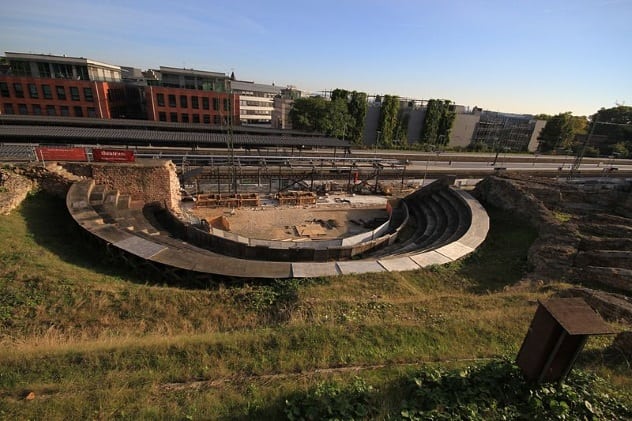
The modern German city of Mainz was once under Roman occupation under the Latin name of Mogotiacum and was considered Rome’s most important city in all of ancient Germania. Unearthed there in 1990 was a 42-meter-wide (138 ft) amphitheater, not too much unlike the great and vast Colosseum. This theater, the size of roughly 1.5 football fields, apparently sat up to 10,000 people, once upon a time.[10] This was a testament to both Roman might and genius, conveying their love for architecture, art, and their rich culture, which generally loved the humanities.
Since being unearthed, not only has the theater become a tourist attraction, but it has been restored and is even used for live performances by artists today. Mogotiacum was an extremely large city, and the extravagance of this theater, the largest north of the Alps, definitely shows it. The Germanic people definitely were diverse and culturally rich, but there’s a reason that so much of what we know and love today was borrowed from their archrivals, Rome, the marvel of the ancient world.
1 Sutton Hoo

Sutton Hoo is pretty much the mother lode of all Germanic excavations. Residing in England, this formerly Anglo-Saxon site lies near Woodbridge in Suffolk. It was discovered in 1939, and its contents have taught us much about this specific group of Germanic people. What’s most impressive about this site is that it’s a burial ground, with all the markings of royalty. A cenotaph, or monument for a grave, was uncovered in the form of none other than a ship burial, which is extremely unusual for the Germanic people who lived in England. This boat measured more than 27 meters (89 ft) long, and various silver and gold objects were found in the vicinity. There were also foreign imported items that came from as far as Greece and the Middle East, with inscriptions in various languages. Whichever king was buried at Sutton Hoo (the identity is still unknown) was someone of great importance, and they were buried with a lot of expensive goods accordingly.
Shortly after Sutton Hoo’s discovery, England entered World War II, and its finds were left to rest for a while until the war wrapped up, but once unearthed, the artifacts showed us most of what we know about the people we call the Anglo-Saxons, from whom even the English language has spawned. These were the real artifacts of the real people who were told of in the work Beowulf. Bowls, forks, cups, you name it; if it was Anglo-Saxon treasure, it was found at Sutton Hoo.[11] It is through excavations like these that we now have a long lineage to trace as we connect the dots of our understanding of the Germanic people from prehistory all the way up until today.
I like to write about dark stuff and history.
Read about more European archaeological discoveries on 10 Recent Discoveries Concerning Ancient Europe and Top 10 Rare And Large Greek Archaeological Discoveries.
